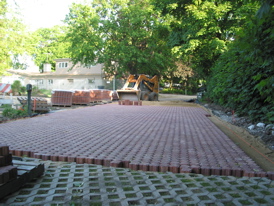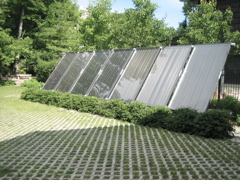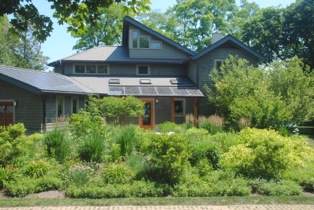
WATER CONSERVATION AND LANDSCAPING
Water conservation is an important component of sustainability, even for those of us fortunate enough to live on the edge of Lake Michigan, a seemingly inexhaustible source of freshwater. In fact, the amount of water that Illinois is allowed to withdraw from the lake is regulated by a U.S. Supreme Court decree, and the state's allocation is almost fully used. Careful management of water resources is even more critical for those Illinois communities that depend on groundwater. Many areas to the west and south of Chicago are already experiencing stresses on water availability and quality, and severe water shortages are projected for at least 22 townships in the metropolitan area by 2020.Using water efficiently is also important as a means to save energy. Electricity is needed to treat and move potable water through municipal water systems and to collect, treat, and discharge wastewater. (And for a community like Evanston, wastewater also includes the rainwater that flows into the city's combined sewer system.) According to the American Council for an Energy Efficient Economy, supplying water and then cleaning it up afterward accounts for about 35 percent of the energy used by municipalities.
CONTENTS
|
Indoor Water Usage
According to the American Water Works Association, indoor water usage in a typical single family home in the U.S. is about 70 gallons/person/day. Installing water-efficient plumbing fixtures and appliances along with repairing leaks, however, can reduce water usage significantly, to around 45 gallons/person/day. Toilets have long been the greatest water user in the house, accounting for more than one-quarter of the total daily indoor water use in a typical single-family home. Older, conventional toilets (those made prior to 1992 when new federal plumbing standards were implemented) use between 3.5 and 8 gallons per flush (gpf). Federal law now mandates that all toilets manufactured in the U.S. must operate on 1.6 gpf or less. Replacing an old 3.5 gpf toilet with a 1.6 gpf toilet can result in substantial water savings--of roughly 10 gallons/person/day. (To determine the flush volume of an older toilet, look for the date of manufacture on the underside of the tank lid or on the back inside wall of the tank. Toilets made from the early 1980s to 1992 use 3.5 gallons/flush. Those made earlier use from 5 to 8 gallons/flush. Newer toilets should have a mark near the seat hinge indicating that they use 1.6 gallons/flush.) The dual-flush toilet takes water efficiency another step further. Instead of just one flushing option, dual-flush toilets allow the user to select either a full 1.6-gallon flush or a "liquid only," 0.8-gallon flush. Long popular in Europe and mandated in Australia and Singapore, the dual-flush toilet is becoming easier to find in this country as well. When Caroma dual-flush toilets were selected for this house just a few years ago, the Australian company dominated the market; now most other major toilet manufacturers offer dual-flush models as well. The EPA has developed a new labeling program to help consumers find high-efficiency toilets and other water-efficient products. Products and services that have earned the WaterSense label have been certified to be at least 20 percent more efficient than similar products on the market and to perform as well as, or better than, their less efficient counterparts. In the case of toilets, the WaterSense label denotes a fixture that uses a maximum of 1.28 gallons/flush. Showerheads and faucets present additional opportunities for water conservation. To meet current federal plumbing standards, showerheads manufactured in the U.S. must restrict water flow to 2.5 gallons per minute (gpm) or less. By replacing older (pre-1992) 4.5-gpm showerheads with new low-flow fixtures, a family of four can save approximately 20,000 gallons of water per year. As for faucets, federal guidelines mandate that they use no more than 2.2 gpm. Replacing older 3-to-7-gpm faucets with more efficient fixtures--or installing low-flow aerators in existing faucets--can achieve significant water savings. And by reducing the demand on the home's water heater, low-flow showerheads and more efficient faucets will result in energy savings as well. To qualify for the WaterSense label, showerheads can use no more than 2.0 gpm, representing a 20 percent reduction in flow rate over the 2.5 gpm federal standard. A WaterSense-labeled bathroom sink faucet can use no more than 1.5 gpm. Water-efficient washing machines and dishwashers can also save thousands of gallons of water annually compared to more conventional models. The EPA has recently revised its ENERGY STAR performance specifications for both categories of appliances: stricter efficiency standards for dishwashers took effect in January 2012, followed by more stringent criteria for clothes washers in February 2013. ENERGY STAR-certified clothes washers use about 35 percent less water and 20 percent less energy than regular washers. And ENERGY STAR dishwashers are, on average, 20 percent more water efficient and 10 percent more energy efficient than non-qualified models. Leaks account for about 13 percent of the water used in a typical home. A slowly dripping faucet or a toilet that keeps "running" can waste thousands of gallons of water a year. To check for leaks, read the water meter before and after a two-hour period in which no water is being used. After the test period, if the meter has a higher reading, there is probably a leak. A few small changes in every day habits can also result in significant water savings. Turning off the tap while brushing your teeth can save well over 1000 gallons/person/year. A five-minute shower (12.5 gallons of water with a new showerhead) instead of a bath will save 20-30 gallons each time. Look for more water saving tips from online resources such as Water: Use It Wisely.
Older urbanized areas face another problem in managing stormwater. Cities like Chicago and Evanston have combined sewer systems in which stormwater and sanitary wastes are collected in the same pipes and conveyed to a treatment plant. Here the rainwater gets treated to the same degree and at the same cost as raw sewage. During heavy rainfalls, when the flow exceeds the treatment and storage capacity of the system, the combined waste stream is allowed to flow into a nearby body of water (e.g., Lake Michigan). Green infrastructure systems, on the other hand, manage rainwater where it falls, treating it as an asset rather than a waste product. One effective green infrastructure solution is to pave driveways and parking areas with permeable paving, which allows rainwater to seep into the ground, thus recharging groundwater and reducing stormwater runoff.
Rainwater harvesting--collecting and storing rainwater for future use on site--is another green alternative to sending this valuable resource into the sewer system. Harvested rainwater is typically used for landscape irrigation but, with proper treatment, can also be used indoors for flushing toilets, washing clothes and even for drinking. Benefits include lower water bills, reduced demand on the municipal water supply, increased groundwater recharge, and more efficient and appropriate use of precious drinking water. At this house, most of the downspouts have been connected to a 1000-gallon underground cistern in the southeast corner of the property. A small pump allows the rain water collected in the cistern to be used for watering the garden. Overflow from the cistern flows into the lake.
Links and Resources
|
Website prepared by Eleanor Revelle.
Last revised: January 2014


